by Marion Patterson | Jun 26, 2025 | (Sub)Urban Homesteading, Garden/Yard, Mammals, Pests
What’s In A Name?
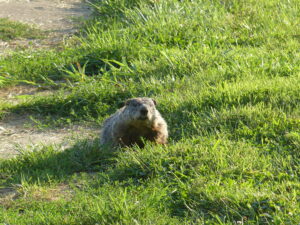
Nibbling on grasses
A big furry animal has made a tunnel under the deck and clear cut down the garden. Is the culprit a woodchuck or groundhog? The answer is simple. They’re two names for the same animal.
The window by Marion’s computer desk overlooks our deck. On a spring morning, she was startled to look out and be face to face with a big woodchuck just outside the glass.
He soon ambled off. A few days later, we were enjoying basking in the sun in our outdoor nook. It’s next to a front lawn that we seeded with white clover last year. Out of the corner of our eye, we caught movement. It was the woodchuck, likely on his way to enjoy a clover lunch. When he spotted us, he quickly exited.
What is a Woodchuck?
Several species of marmots live across the northern hemisphere. Visitors to western national parks often see the Yellow-Bellied Marmot in higher elevations, but the one most Americans spot is the amazingly abundant woodchuck.
Woodchucks live in both suburban and rural areas from the Atlantic Ocean westward to Nebraska and Kansas and north to Hudson’s Bay and even Alaska.

Woodchucks are great tunnelers.
They are an amazing adaptable vegetarian. Among North American rodents only beavers are bigger. A huge male “chuck” can weigh up to 15 pounds. As rodents they have impressive incisor teeth and powerful legs perfect for digging burrows under decks or inside or near old sheds and brush piles.
True hibernators, male woodchucks emerge from their burrows in March here in Iowa. Females wait a few weeks and usually end their winter slumber in April. They’ll soon have three to five pups. As soon as the babies’ eyes open, mom will bring them outside where they learn to dine on a wide range of vegetation. They love garden vegetables. Perhaps nothing is as tasty as beans, lettuce, or Swiss chard.
Tree Climbers?
Most people realize woodchucks are excellent diggers, but few recognize they are squirrels adept at climbing trees. On hot summer afternoons, they love resting on a shady and breezy tree branch.
Reducing Woodchuck Damage
Although they’re big and active during the day, woodchucks are wary and usually vanish when they spot a person. They can’t hide the huge mound of dirt by their burrow, and a clear-cut bean patch also may mark their presence.
How do you reduce woodchuck damage? Since they can burrow, run, and climb, it’s challenging keeping them out of a yard or garden.
These Actions Can Help
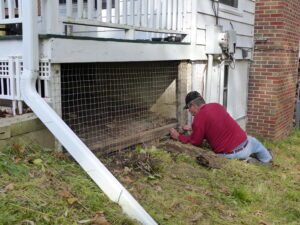
Rich placing wires to prevent woodchucks from digging under the porch.
Fencing: A stout fence around a garden or deck can make access challenging. The fence needs to be dug into the ground. Placing a mesh of stout fencing on the ground under a deck will reduce the odds that a chuck will burrow there, but it has to be done before the animal starts making its home.
Dog: An alert dog will chase chucks away.
Altering the yard: Removing brush piles where chucks like to burrow will encourage them to create a home elsewhere.
Trapping: Woodchucks are usually easy to catch in a box-type live trap. Set the trap near the burrow and bait it with bits of apple or other fruit. It helps to cover the trap with a tarp or some brush, as they feel more secure underneath something.
There’s a problem
What do you do with a healthy but very unhappy chuck caught in a box trap? Keep fingers out of the trap! Call the town animal control officer(s) and ask for their suggestions on what to do with it. We don’t advocate taking it on a long drive and releasing it in the country. It seems unethical to “give” the animal to someone who lives near the release area. Preventing damage is always best, but sometimes euthanizing a problem chuck is the best solution.
Woodchucks are amazing animals. We enjoy seeing them as long as they stay out of the garden!
by Winding Pathways | Jun 19, 2025 | (Sub)Urban Homesteading, Flowers/Grasses, Garden/Yard, Garden/Yard
Years ago, anyone attempting to create a diverse, native landscape in their yard sometimes experienced weed ordinance woes. Their local ‘weed commissioner” would order them to mow their “messy” yard.
Towns created ordinances to give them the authority to force landowners to remove what was perceived to be health or safety hazards. But, they were sometimes used to enforce conformity to the standard of neatly mowed, sprayed, monoculture lawns promoted by lawn product and care companies.
Cities do need the authority to deal with situations where landowners simply neglect their yards by not mowing, but they should not be able to use ordinances to enforce an aesthetic standard.
Changing Times – Responding to Declining Pollinator Populations
These days, homeowners everywhere recognize the importance of diversity. They are creating diverse landscapes of native plants even in tiny yards. Towns are responding by altering restrictive ordinances to allow the restoration of beautiful vegetation that supports beneficial wildlife, including pollinators.
Anyone who plans to diversify their yard in a way that makes it look different from their neighbors’ runs a risk of running afoul of their local town’s ordinance.
Guidelines To Reduce Neighbor or Municipal Friction.
- Research your town’s weed ordinance. Often, it’s printed on the town’s website.
- Develop a written plan and diagram of what the yard will become. It doesn’t need to be fancy or detailed.
- Cultivate and educate neighbors. Even towns that have old-fashioned ordinances rarely go out of their way to enforce them. Enforcement is triggered by complaints, usually from neighbors. Sharing a yard’s plan with neighbors before the change takes place may help them understand that what you are doing isn’t neglect.
- Start small. Maybe just replace a corner of a yard with prairie the first year and expand it gradually as the years go by.
- Make the yard look tended and not neglected. This can mean mowing pathways through tall grass, maintaining some lawns, and often being seen tending the yard tending the landscape.
- Avoid health or safety hazards. Avoid planting taller vegetation that will block a driver’s vision at intersections. Don’t allow allergens like poison ivy or ragweed to grow.
- Hiring a knowledgeable professional yard care company to plan and implement diversity.
Results
Restoring a gorgeous landscape of native vegetation is a delightful project that makes our world a bit healthier. Doing so is easier if it doesn’t irritate neighbors or invoke a stern town ordinance.
-
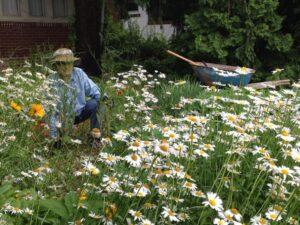
-
Native and cultivated plants brighten a front yard.
-
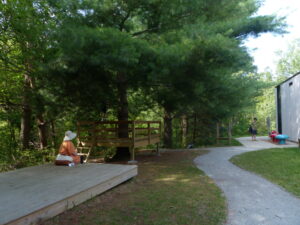
-
Families outside
-
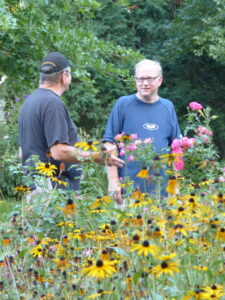
-
Converting a yard to more natural plants brings joy.
This first appeared on the Sustainable Landscape Solutions Website at sustainable landscape solutions.org. The company is based in Iowa City, Iowa, and helps landowners create wondrous yards.
by Winding Pathways | Mar 13, 2025 | (Sub)Urban Homesteading, Chickens, Garden/Yard
Soaring Prices Cause People to Question
Does keeping a backyard flock make sense?
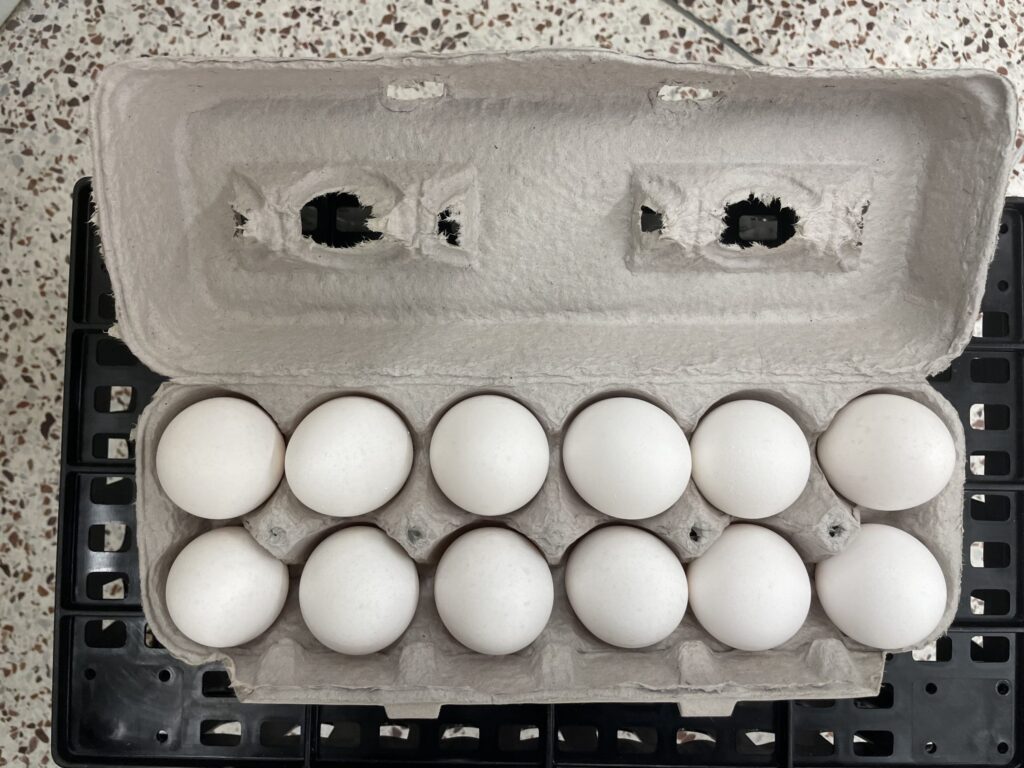
Store eggs come from one breed of chickens.
While shopping at a nearby grocery store, we noticed eggs for sale at $6 with a purchase limit of two dozen. After returning home, we visited our backyard coop and collected eight eggs, which is a fairly typical daily production from our ten hens.
With egg prices soaring and availability uncertain, many people are considering building a coop, buying chicks, and producing eggs in the backyard.
Consider Carefully
Does a backyard flock make sense, or is investing in one a way to save money? Is it a good idea to keep chickens?
It depends. Ask first, what is your lifestyle? Do you like working around a yard and tending animals? Will you keep the coop and run clean? How much space do you have for a small flock? What other animals do you have? How often do you travel? What is your relationship with neighbors? Is keeping a small flock legal in your community?
Then, do your research.
We’ve tended small backyard flocks for nearly 50 years and have much experience managing chickens. Fortunately, many towns and cities changed their ordinances to allow suburban and urban flocks and thousands of families have begun keeping chickens. For those willing to do the daily work, they are well suited for suburbia.
Will A Backyard Flock Reduce the Grocery Bill?
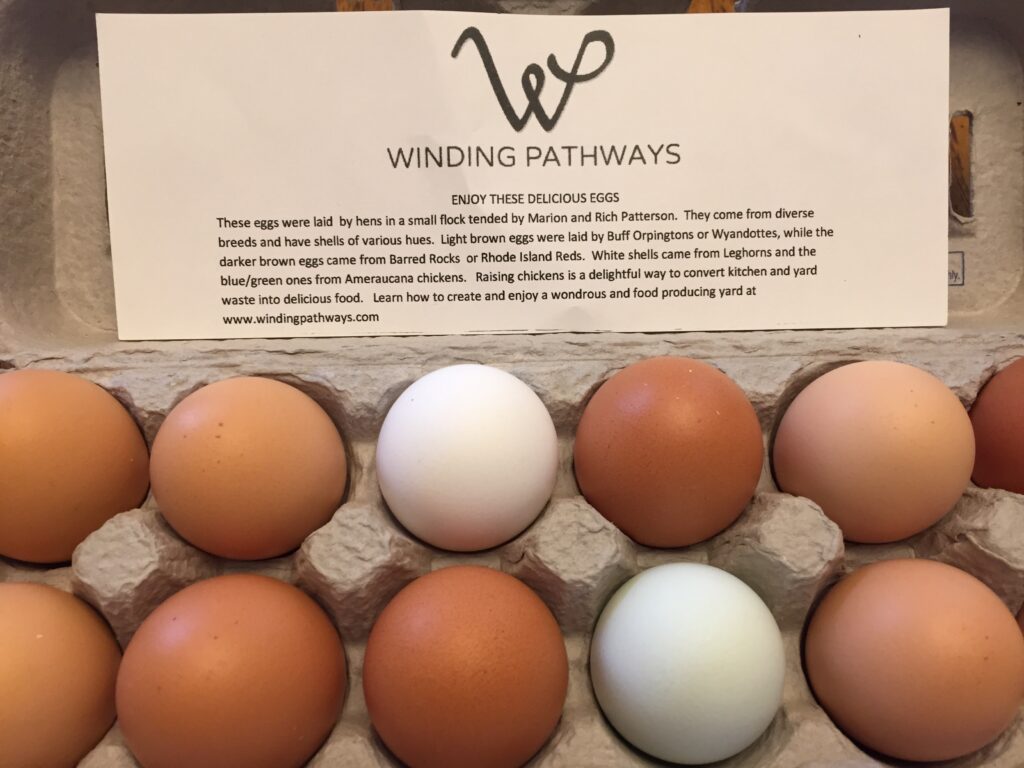
Beautiful eggs
For many families chickens are a rewarding hobby with a side benefit of delicious food and garden fertilizer. But, do those hens produce eggs at a lower price than at the grocery?
Maybe.
What is Economy of Scale?
Huge commercial egg producing farms house millions of layers of genetic strains developed for maximum egg production. They buy feed at huge discounts.
Their economy of scale has, until recently, enabled grocery stores to sell eggs at amazingly low prices.
In contrast, there’s no economy of scale in caring for a small flock. Stores offer no discounts when buying a bag or two of layer feed. It costs us about $5 a dozen to produce eggs from our ten-hen flock. So, at today’s prices we’re probably saving a little money, but during normal times our backyard eggs are more expensive than store bought ones.
More Than Money
That’s only part of the picture. We can count on our hens to lay eggs every day. Recently our grocery store was out of eggs. Reliability is a benefit and there’s more.
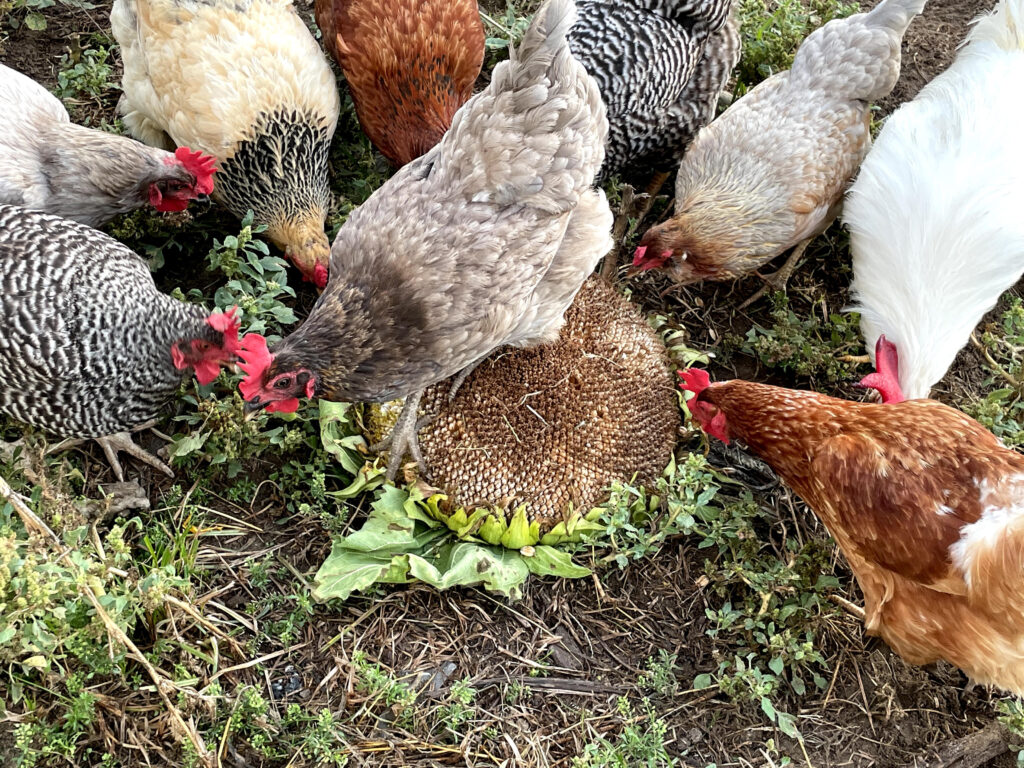
Chicken enjoy varied diet
We take pride in producing as much of our food in our yard as possible. Both garden vegetables and backyard eggs are absolutely fresh, delicious, and reliable. And, we know our chickens are raised humanely. We like them. They are fun. Our chickens give us a laugh with their comic peculiarities. They are beautiful. They talk to each other and clearly communicate, recognize us and eagerly anticipate the treats we give them daily.
Our End Benefit
For us producing food is a satisfying activity that gives us both peace of mind and pleasure.
Should A Family Tend a Backyard Flock?
Caring for any living creature entails responsibility. Chickens, like a family dog or cat, need daily care that can be time-consuming. If a family enjoys animals and is willing to devote time and energy to their daily care, a backyard chicken flock may fit perfectly into their lifestyle and yield eggs. Caring for chickens can be an enjoyable family project, an educational adventure for children with fresh eggs as a bonus.
However, if a family sees a flock solely to save money at the grocery and doesn’t enjoy daily animal care, establishing a flock is a mistake.
There’s a lot to learn when establishing a chicken hobby. Excellent information is available on our own website Winding Pathways or the Hoover’s Hatchery website. Many physical books and online sources also help with learning.
Final thought: Remember, make it fun!
by Winding Pathways | Mar 6, 2025 | Chickens, Garden/Yard
What is a Marshmallow Scramble?*
- It’s an easy, entertaining way to get chicks to come home for the night.
Every afternoon, with great enthusiasm, our chickens do the marshmallow scramble. Until recently we didn’t know chickens love the sugary balls of puff, but neighbor, Joann Hoffman, a chicken aficionado demonstrated with her small flock. As her small flock of hens gathered around her in anticipation, she tossed out a few mini marshmallows. The tiny treats vanished in a flash!
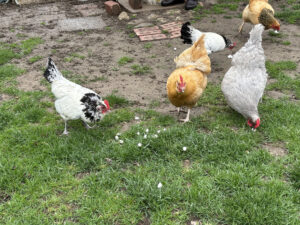
Chickens love treats!
We bought a few bags of baby marshmallows on our next foray at the grocery store. That afternoon we tossed a handful to our chickens. Cocking their heads, they eyed them with suspicion. Stepping close, cocking their heads another way, stepping away with disdain, then stepping back in as curiosity overcame their caution. One finally sampled the strange tidbit. Then, scrambled for more. Other chickens scrambled for a taste of this exotic, new “food.”
Understand, please that the marshmallow scramble is a special treat. We make sure the hens and rooster have plenty of nutritious foods and treats especially in the winter.
Now, marshmallow time happens every afternoon when we want to lure the hens into the coop for the night. They’ve even learned the phrase, “marshmallow time.” When we shout those words the flock scurries into the coop. We toss in marshmallows and enjoy watching the wild marshmallow scramble. While they’re busy snapping them up we close the pop hole door, securing the coop from nocturnal predators.
Take a look at this mad chicken marshmallow scramble.
While putting the blog together we even learned some about the history of marshmallows. Kind of interesting.
by Winding Pathways | Jan 16, 2025 | (Sub)Urban Homesteading, Garden/Yard, Garden/Yard
Seed Catalog Reading
We trudged through the snow to retrieve our first garden catalog. Excited! So, we wondered what our gardening friends thought of about the best garden vegetables to grow in tiny spaces. They replied about small spaces and in general.
Garden seed catalogs hold spring’s promise in your hands. These seem to sprout in mailboxes during winter’s depth. In addition to being fun reading on dark winter nights, they help plan springtime seed planting.
Changing How We Garden
We have plenty of space at Winding Pathways to create a big garden, but we decided to grow vegetables on two small garden plots years ago. Their modest size makes them easy to manage, but mostly we wanted to learn how to grow a maximum amount of the best garden vegetables from a small area. Not everyone has large spaces and as people age adapting to how they continue to enjoy a practice, like gardening, is important.
During the 2024 growing season, our gardens produced an amazing amount of food. We saved money by providing ultra-fresh pesticide-free vegetables and enjoyed nearly year-round tasty vegetables.
Readers Share Their Best Garden Vegetables
We asked a few seasoned gardeners what their favorite small space crop is.
Master gardener, Iris Muchmore, has a small backyard garden. Her absolute favorite planting is a Sun Gold Tomato. She points out that tomatoes aren’t really vegetables. They’re a fruit, but most folks consider them a vegetable. “The Sun Gold tomato is indeterminate, tasty, as sweet as candy, and productive. Children love them. One plant will grow up to seven feet tall and produce all the tomatoes a family can eat with some extras for neighbors. In 2024 we enjoyed tomatoes from June until frost from one plant,” she said.
Jackie Hull is a seasoned Virginia gardener. Her favorite vegetables are string beans, both green and yellow. She’s 83 years old and grows beans in large pots on her porch. “It makes gardening easy. There’s no weeding, only watering and picking,” she remarked.
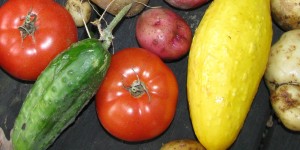
Tasty high summer garden fruits and vegetables.
Bruce Bachman & Nancy Sauerman buy from Pinetree Garden Seeds in Maine. They comment that their favorite garden vegetable is a “…tie between tomatoes and green beans. Although potatoes, chard, and broccoli are close seconds.” Then they added with a laugh, “Oh! forgot summer and winter squash! Oops, and okra and spring lettuce.” All favorites of theirs.
Iowa Gardener, Dave Kramer, responded by stating, “I like the challenge of growing different tomato varieties and growing string beans”
Kurt Rogahn also weighed in, choosing tomatoes as his favorite. “Tomato is my favorite. The ones in the store are so tasteless! I like different varieties— red, yellow, orange, big and small.”
Jill Jones, could hardly decide as she likes just about all vegetables. And, she prepares delicious dishes from her garden produce.
Joann Hoffmann weighed in with these thoughts: She starts greens in a colander!
“I would say my favorite is a nice salad mix with arugula, red lettuce and green lettuce. You can grow it in a colander. It’s an early vegetable, likes cool weather. It makes a great base for salads all summer long. You can start it in April when it’s too early for other vegetables. As the season progresses you can add kale, swiss chard, turnup greens, mustard greens, mint, peppermint, tomatoes, cucumbers, spinach, and cilantro. Try it and enjoy great tasting salads all summer long!!”
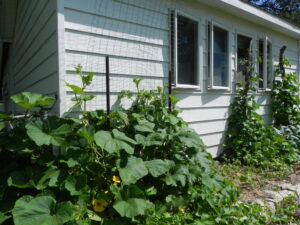
Our Favorite Vegetable For Small Spaces
We’ve gardened for about 50 years, growing all sorts of vegetables, and are constantly experimenting with new varieties. Along the theme of Small spaces” here is our number one favorite:
Swiss Chard: Chard is a green delicious when steamed or raw in salads. We plant it in April and often eat young leaves within a month. Unlike spinach and lettuce, chard doesn’t bolt, or go to seed, and get bitter. So, we eat chard from the same clump for about five months without replanting. About two square feet of space produce all the chard we can eat. It’s an outstanding plant for folks who live in apartments and only can grow a few things in pots on the deck.
Susan Fellows is one of those people. “It’s not strong like the greens grown in the South and less strong than spinach.” She enjoys snipping off a few leaves, steaming them, and adding butter. Delicious and nutritious!
Swiss chard is the same species as beet but it’s been developed as a green vegetable. There are several varieties. All are good. Beet tops are also delicious when steamed, but they are a bit stringier and tougher than chard.
Number Two of Best Garden Vegetables
Green and yellow beans are our second favorite for our small space garden. We use two methods to create a constant harvest from June through October. We plant a small patch of bush beans in May. They produce beans quickly and the plot yields heavily for a month before the plants peter out. Anticipating this, we start another small bean plot several feet away about a month after the first planting. By the time the first plot is done, the second one starts producing like crazy. We also plant a row of pole beans next to a garden fence. They mature slower than bush beans but produce from August until frost. String beans provide great food for nearly every dinner for months.

Promise of spring
Enjoy leafing through winter garden catalogs and place seed orders early in anticipation of delicious 2025 eating. Be sure to put Sun Gold, string beans, and Swiss chard on the order list.
Some quality seed companies we buy from:
Pinetree Seeds, New Gloucester ME
Seed Savers, Decorah, IA
Gurney’s Seed and Nursery, Greendale, IN
Burpee, Warminster Township, PA
Jung Seeds & Plants, Randolph, WI
by Winding Pathways | Dec 5, 2024 | (Sub)Urban Homesteading, Energy Efficiency, Garden/Yard, Garden/Yard
*Note: Below are just a few examples of several power tools we’ve purchased. They were pricey but made yard work so much easier than with muscle-powered tools. Occasionally, a company asks us to try a product and give reviews.
Yard work was a snap when we were in our 20s. That was a half-century ago! How can that possibly be? Years slipped by. We’re just as eager to mow grass, rake leaves, plant gardens, prune shrubs, and shovel snow, but muscles and joints make the work challenging. Fortunately, we’ve found ways to make yard work and house repairs easier for us as aging homeowners. People with reduced strength or mobility and even younger people with busy schedules will find these tips handy.
Here are some ways we’ve made yard management easier:
Invest in Tools
Tool companies have made yard care easier and safer than in the old days. We used to use muscle-powered tools to trim hedges and shrubs, cut and split wood, rake leaves, move snow, and till the garden. As we got older we began investing in power tools that make the work easier and faster.
For example, an old fashioned “weed wacker”, powered by arm muscles, cut down tall grass growing into pathways and our woods. That got harder each year, so we invested in a Milwaukee brand battery-powered tool that fuels a weed cutter, pole saw, and hedge trimmer. The work is quick and easy. Same with our lopping shears for trimming trees. A battery-powered pruner does the tough cutting easier than hand muscles.
-

-
spring loaded vs battery
-
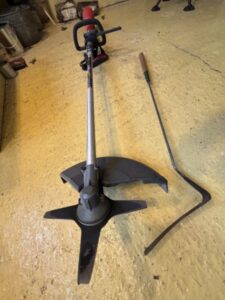
-
Long handle
-

-
Muscle powered shears next to hedge trimmer.
We always had a gas lawn mower but often struggled to pull the darn starter cord. When EGO came up with a battery-powered mower we eagerly bought one and got rid of the old gas mower. The EGO starts by pushing a button, and it’s self-propelled. We have to walk behind and guide it, but it chugs along under its own power. That’s especially helpful when we mow trails on our hillside.
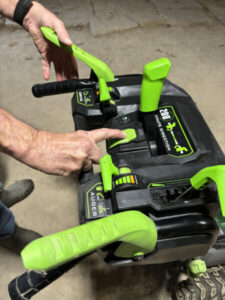
The EGO snowblower starts with a push of a button.
Snow shovels! Well, we still have a few and use them in tight spaces, but our relatively new battery-powered snow blower makes clearing our 440-foot driveway a snap and eliminates the need to lift heavy snow and pull a starter cord.
Those are just a few examples of several power tools we’ve purchased. They were pricey but made yard work so much easier than with muscle-powered tools.
Hiring and Borrowing
This past season we did a “first”. We hired a young woman to help with gardening. And, we sometimes hire a local teenager to mow our lawn. Years ago we wouldn’t have dreamed of hiring anyone to do what we could do. That’s changing. Having extra hands to help is money well spent.
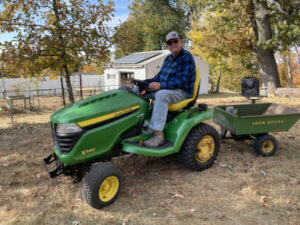
The tractor made hauling wood easier.
It’s not always hiring help. We swap. By late October Rich had cut and split a small mountain of cordwood we’ll use to stay warm this winter. There was a problem. It was on the north side of our property and down a steep hill. In past years he’s hand carried it uphill. Not a small task to muscle 2000 pounds of wood in 50 round trips carrying 40 pounds up the hill each time. Whew. This year a neighbor came to our rescue. Rich borrowed his tractor and trailer and moved all the wood up the hill in a jiffy. From time to time, we have loaned him some of our tools in exchange. Borrowing works both ways.
We pride ourselves on our independence and take joy in yard work, but we just turned 75 and aren’t quite as frisky as we once were. Using power tools, hiring help, and cooperating with neighbors all make keeping up with the yard easier.


















